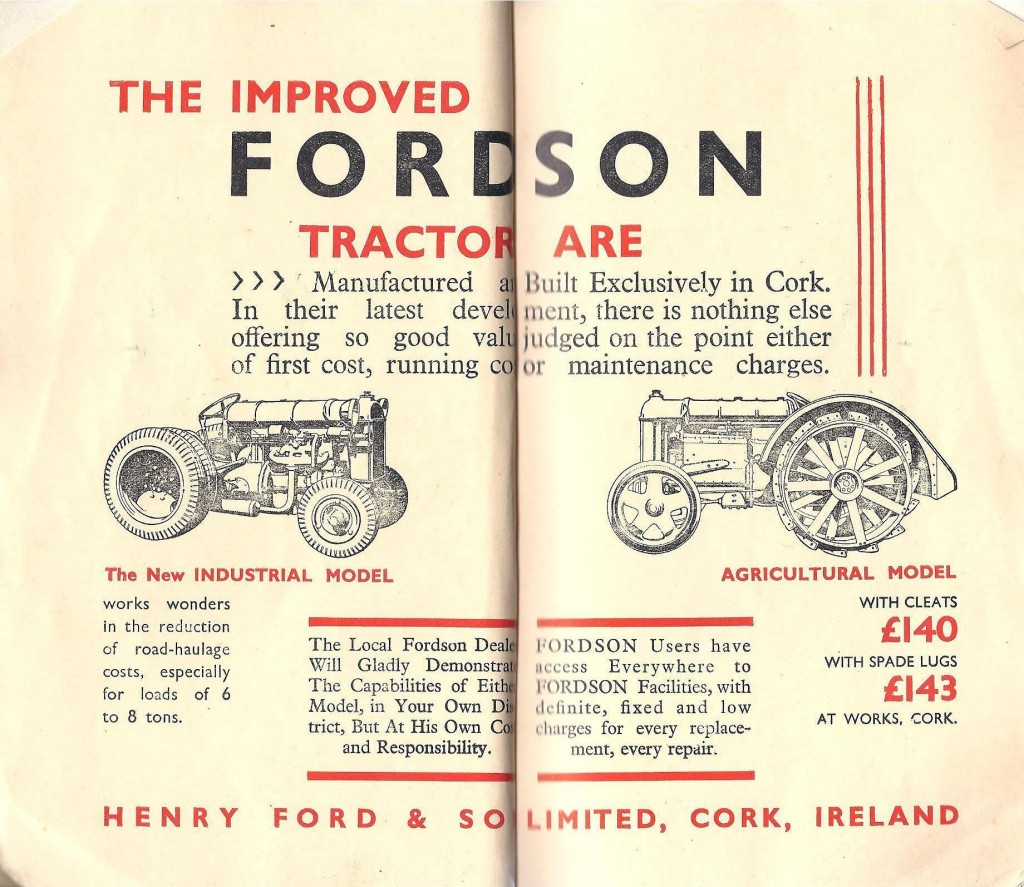
Kieran’s Our City, Our Town Article,
Cork Independent, 2 December 2010
In the Footsteps of St. Finbarre (Part 239)
Cork on Display
According to the catalogue for the Palace of Industries or principal exhibition hall at the Irish Agricultural and Industrial Fair, Cork in 1932, Cork industry was very well represented. Murphy’s Brewers, Blackpool exhibited casks and bottles demonstrating their draught and bottled stout. In addition samples of hops and malt, made only from Irish barley, were presented. Work at branch factories at the West Cork Bottling Co. Ltd, Bandon and W.H. O’Sullivan and Sons, Killmallock, who manufactured minerals of all descriptions, was also highlighted.
Occupying stand numbers 40 to 45, T. Lyons and Co. Ltd displayed samples of their well known ‘Gent’s Ready Made’ suits and shirts produced in their own factories at South Main Street, Cork. They employed a great number of people and the clothing factory was one of the oldest in Ireland. Research by the excellent Cork City library’s website www.cork pastandpresent.ie notes that in the 1790s Thomas Lyons opened a woollen draper’s shop in Tuckey Street. The shop moved to the South Main Street in the 1800s. By 1892 the firm had become a major commercial enterprise. Its frontage was on the western part of the site of the present-day Bishop Lucey Park. The company worked over an extensive and conveniently arranged block of buildings, which included an immense warehouse having a total floorage area of 200,000 square feet. Lyons & Co. Ltd remained in business until the late 1960s. The retail houses associated with the South Main Street site were also represented at the 1932 fair. The Queen’s Old Castle had a comprehensive exhibit of the famous art silk manufacturers Messrs. Courtaulds, Ltd, covering a wide range of their patterns and designs.
Stand no. 46 was the Irish Hospitals Trust from Dublin but they had a Cork Office at no.2 South Mall, Cork. Held in aid of hospitals in the Irish Free State, the ‘Irish Free State Hospitals’ Sweepstake’ was conducted and managed by a committee, including Viscount Powerscourt, Sir Thomas Myles, Sir William Taylor, Sir Conway Dwyer, Sir Joseph Glynn and Dr. P. McArdle. An article by M. Coleman in the Irish Economic and Social History in 2002 and research most recently shown in a TG4 documentary, they revealed that that the sweepstake was a horse-racing based lottery established in the Irish Free State in 1930 to build new hospitals and improve facilities in existing ones. During the 1930s alone gross income from the sweepstake was £71 million, of which £45 million was allocated in prizes and £13.5 million to hospital building. It closed in 1987 and was replaced by the present-day Irish National Lottery.
Cash & Co. Ltd. Patrick Street occupied stand no. 50 and 51 and displayed complete furnishings, all of Irish manufacture such as Irish carpets and Irish linen, for sitting rooms and bedrooms. In 1877 the firm J. Carmichael & Co. became a private company with the title Cash and Company Ltd. After various changes of ownership during the 1970s and 1980s, the company was sold to Brown Thomas in April 1991. It was officially renamed Brown Thomas on 27 March 1998.
Brabants & Co. of 76 Grand Parade occupied stand no. 54 and exhibited the latest marconiphone productions and the latest idea in battery manufacture by Exide plus a display of manufacturing gramophone records. Radio in Britain grew with the birth of the BBC in 1922 and the ‘wireless’ became popular in well-off homes across Britain and Ireland by the early 1930s. Robert Scott & Co. Ltd, ironmongers, of St. Patrick’s Quay occupied stand no. 55. They displayed a range of spades and shovels for all districts in the Irish Free State as well as turf slanes, griffuans, axle arms, cart axles, pickaxes, field Gates. All products were made in their works at Monard. Henry Ford & Son Ltd. occupied stands no.59 and 60. Originally set up in April 1917, the company was incorporated to build Ford cars. Post the global depression from the Wall Street Crash of 1929, it diversified into manufacturing tractors at their Marina site. Exhibits at the Cork Fair showed the details of the up to date improved tractor types as adapted for agricultural and industrial haulage purposes.
T. O’Gorman of 8 and 16 Pope’s Quay were at stands number 62 and 63. The firm made hats, caps, braces and garters. In 1940, O’Gormans took over the Butter Exchange Building in Shandon for its hat factory until it was destroyed by fire in 1976. The last stand in the Palace of Industries (stand no.65 and 66) was P.O’Sullivan & Co., Red Abbey Tobacco Factory, 19 Mary Street. They were manufacturers of coupon plug, coil and roll tobacco, Red Abbey Snuff in 1/2 –oz. Tins and Cork and High Toast Snuff. Paddy O’Sullivan was an astute entrepreneur who had travelled to America to study the techniques of growing and processing tobacco. It proved to be a profitable crop for farmers who participated in it in the late 1920s and early 1930s. In 1927, Paddy O’Sullivan decided to “cut out the middle man” and built a tobacco and snuff manufacturing plant in Mary Street (now the site of the revamped Red Abbey Square). The legacy of this factory is in the current Cork company, M.&P. O’Sullivan.
To be continued…
Captions:
568a. Advertisement for Fordson Tractors, from catalogue for the Irish Industrial and Agricultural Fair, Cork, 1932 (source: Cork Museum)
568b. Advertisement for Irish Hospital Sweepstakes, from catalogue for the Fair (source: Cork Museum)
